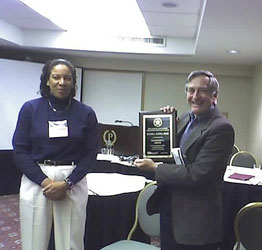Dr. Dawn Wright (UCSB PhD, class of ’94) presented Emeritus Professor Ray Smith the R.J. Russell award for his many contributions to the study of marine environments at the recent Chicago meeting of the Coastal and Marine Geography specialty group of the Association of American Geographers. The R. J. Russell Award is named in honor of Richard Joel Russell (1895-1971) who was Dean of the Graduate School at Louisiana State University for 12 years, an organizer of the Coastal Studies Institute (1954), president of both the Association of American Geographers (1948) and the Geological Society of America (1957), and named to the National Academy of Sciences (1959). Below is the text of Dr. Wright’s nomination letter (photo of the award presentation provided by Richard Daniels).
It is my privilege to nominate Dr. Raymond C. Smith for the R.J. Russell Award. In looking at past Russell Award recipients, it appears that, if Dr. Smith’s nomination is successful, he will become the first marine geographer to receive the award. Dr. Smith’s contributions are in the areas of marine geography in general, and, within that, earth system science, marine bio-optics, marine ecology, and satellite oceanography. In a 40+-year career that began with a post-doc at Harvard, nineteen years at Scripps Institution of Oceanography, and is now drawing to a close at UCSB, he has displayed extraordinary research acumen and leadership. A significant example is his service from 1988 to 1991 as chair of the Department of Geography at UCSB, where he oversaw the establishment of the first focal area in marine geography (in terms of faculty hires, coursework, and research programs) within a geography department in the U.S. This laid the groundwork for UCSB’s current reputation as a leading campus for marine geography and general marine science.
While at UCSB, he also founded the University of California Marine Bio-Optics Group (with UCSD) and was co-founder (with Jeff Dozier) and first Director of the Center for Remote Sensing and Environmental Optics (which is now called the Institute for Computational Earth System Science). From 1993-2002, he served as lead PI of the Long Term Ecological Research station at Palmer, Antarctica and continues collaborative research with this group. Dr. Smith has authored and co-authored over 150 articles of the highest quality that have had major impacts on optical oceanography, marine ecology, and marine geography (including several in “Science” and “BioScience”). For example, Dr. Smith’s research has contributed much to our understanding of how the ozone hole over Antarctica has severely impacted marine ecosystems. Recent research has shown how global warming has influenced the Antarctic marine ecosystem, from primary production all the way up the food chain to marine mammals and birds. He has also developed several novel optical instruments, including spectral radiometers to measure light in the ocean from the visible to the ultraviolet. These were integrated into BOPS (biooptical profiling system), which is the forerunner of many systems that have been used for ocean color remote sensing from space and bio-optical profiling in the water column. His work is referenced in CoMa’s contributing chapter to “Geography in America at the Dawn of the 21st Century,” edited by Gaile and Wilmott (2004).
And, finally, Dr. Smith has proved to be a tremendous teacher and mentor over the years, having produced a host of M.S. and doctoral students who are making further impacts in marine geography and oceanography, as well as successful and popular geography courses in ocean remote sensing, physical geography, and navigation (which included night-time star-gazing labs on the Goleta bluffs overlooking the Pacific Ocean).


